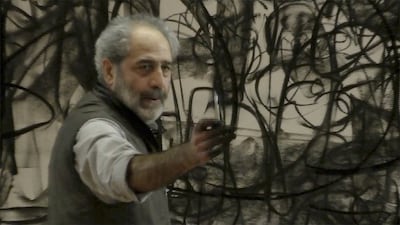International screenings of a recorded drawing and sound performance by a UK-based artist commemorating the Syrian war are taking place at cultural and religious institutions in honour of Refugee Week.
Syrian-born Issam Kourbaj first unveiled Imploded, Burnt, Turned to Ash at the Howard Theatre in Cambridge via a live-stream in March last year to mark the 10th anniversary of the first anti-government protests in his home country.
With backing music from composer Richard Causton and soprano singer Jessica Summers, Kourbaj filmed himself creating and destroying his drawings for 36 minutes and eight seconds. Screenings will take place at physical locations in the UK, the UAE, Kuwait, the Netherlands and the US.
The recording sees a blindfolded Kourbaj scrawling in charcoal on a wide white canvas, in homage to the anti-government graffiti that sparked mass public protests in Syria 11 years ago.
After drawing on what looks like a replicated wall, Kourbaj tears up the paper and sets fire to the pieces in a barrel drum, referencing the “many Syrian eyes that were … burnt and brutally closed forever.”
The artist’s only live performance of Imploded, Burnt, Turned to Ash coincided with his Don't Wash Your Hands display — a collection of 366 eye idol sculptures made from Aleppo soap — at Cambridge's Fitzwilliam Museum.
While Syria remains central to Kourbaj’s performance piece, including the poem he composed to go with it, the artist tells The National that the tragedies of war and refugees reflected in theart are “more than ever global issues”.
“It isn’t only about Syria, the tragedy of refugees is worldwide. It is the same now in Ukraine. Unfortunately, we aren’t learning the lessons and I want to flag to audiences the issue of destruction and how it forces people to flee for survival, like any person would do,” says Kourbaj.
At least 500,000 people have been killed during the Syrian war between regime loyalists, anti-government protesters, and later, multiple foreign armies engaged in a proxy war.
The multi-sided conflict has created one of the largest refugee crises in contemporary history, with more than 13 million fleeing the country or being displaced within its borders.
Having moved to the UK in the 1980s to pursue his art, Kourbaj is not a refugee himself though he nevertheless feels exiled from his home country for political reasons.
Since the war began, the artist has made the country the focus of his work, often addressing the plight of victims of war and displacement.
In 2020, Dark Water, Burning World — a collection of 12 boat sculptures made from bicycle mudguards and filled with matchsticks — was chosen as a special addition to the British Museum's “History of the World in 100 Objects”.
To commemorate Refugee Week from June 20 to 26, the recording of Kourbaj’s performance is being screened across the UK, Europe, the Middle East and the US. It will also be available to watch online.
Produced in collaboration with Kettle’s Yard, The Heong Gallery and The Fitzwilliam Museum, the organisers say the physical and digital multi-screenings reflect “the diaspora of many Syrians forced to leave their destroyed homes and erased cities, who are now scattered across the world.”
The ash produced during the original performance, which the artist says “casts light on war’s terrible continuity”, will also be installed in a glass vessel next to the screen at some locations, including at St James’s Piccadilly in London and Great St Mary’s, the university church in Cambridge.
After training at the Institute of Fine Arts in Damascus, Kourbaj moved to St Petersburg to study architecture before going to Wimbledon School of Art in south London to apply himself to theatre design.
He has been living in Cambridge since 1990 after an exhibition of his drawings went on display there with some of the finest artists of the day, paving the way for him to become an Artist-in-Residence, a Bye-Fellow, and now a lector in art at Christ’s College Cambridge.










